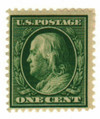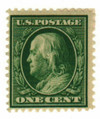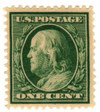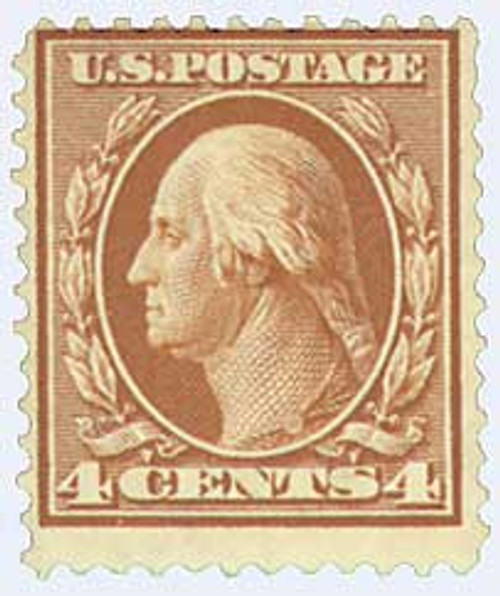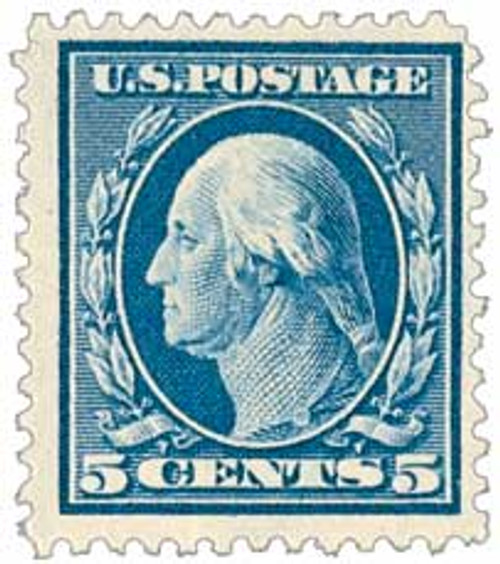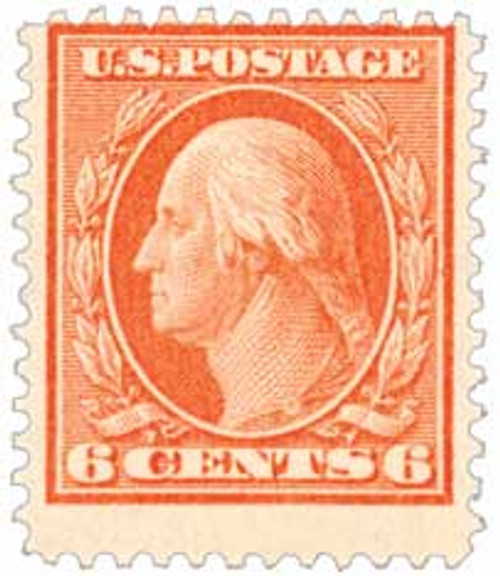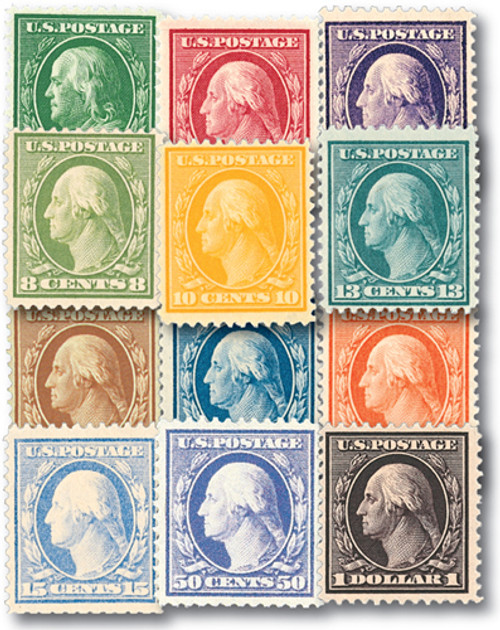
# 331 - 1908 1c Franklin, double line watermark
Series of 1908-09 1¢ Franklin
Quantity issued: 5,300,000,000 (estimate)
Printed by: Bureau of Engraving and Printing
Method: Flat plate
Watermark: Double line
Perforation: 12
Color: Green
Birth of Jean-Antoine Houdon
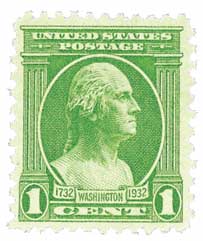
Renowned sculptor Jean-Antoine Houdon was born on March 25, 1741, in Versailles, France. He sculpted a number of high-profile figures during his life, including George Washington, Benjamin Franklin, Voltaire, Thomas Jefferson, Robert Fulton, Napoleon Bonaparte, and more.
Houdon’s father was a servant who worked in the home of a high-ranking aristocrat. In 1749, that home began hosting the newly created Élèves Protégés, a special school for people who received the Prix de Rome. As a result, Houdon grew up surrounded by the day’s best crown-sponsored artists. He apprenticed with sculptor Michel Ange Slodtz and then won the Prix de Rome himself in 1761, enabling him to study at the Élèves Protégés.
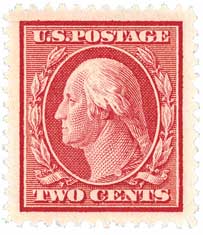
Houdon enjoyed his time in Rome, studying classical sculptures. In fact, the students were tasked with copying famed marble sculptures that would be displayed in the royal gardens in France. Houdon returned to Paris in 1768 and was invited to show his work at the prestigious Salon. While his work was widely praised by many, he didn’t impress the director of major crown commissions. However, Houdon’s 1771 terracotta bust of French philosopher Denis Diderot earned him significant attention, particularly from foreign nobles and other high-society figures. Houdon created several busts of author Voltaire that inspired valuable commissions for seated Voltaire sculptures.
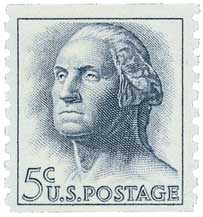
In the 1770s and 80s, Houdon befriended a number of American dignitaries living in Paris, including Benjamin Franklin, John Paul Jones, and Thomas Jefferson. He sculpted each of these men and Jefferson encouraged him to go to America to sculpt George Washington. Houdon spent weeks in 1785 at Washington’s Mount Vernon home and studied him carefully. On one occasion, Washington became angry about a horse trader’s prices and ordered the man off his property. At that moment, Houdon found the expression of pride and strength that inspired a nation. Houdon set off to capture the expression in his sculpture. The artist prepared a clay bust and a plaster life mask of Washington before returning to France to complete his work. Houdon’s bust of Washington is regarded as the most accurate representation of George Washington’s face in existence.
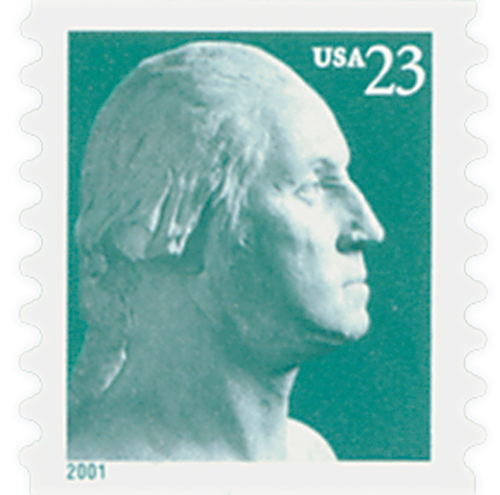
Houdon was commissioned to sculpt a wide variety of figures – magicians, magistrates, ministers, and the royal family. He also created plaster models of statues that he hoped would impress patrons to pay for them to be made in bronze or marble.
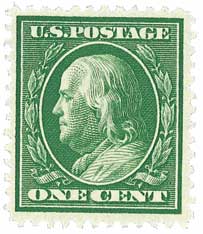
In 1786 he got married and had three daughters. His sculptures of them are considered some of his finest works picturing children. During the French Revolution he fell out of favor because of his connections to the royal court. But after the war, he again held a prominent position in the art community and worked on the Column of the Grand Armée. He was made a Chevalier of the Legion of Honor in 1804. He completed his final American commissions the year before, depicting inventor Robert Fulton and poet Joel Barlow. He also did his last commission for imperial Russia of Czar Alexander I. Houdon died on July 15, 1828.
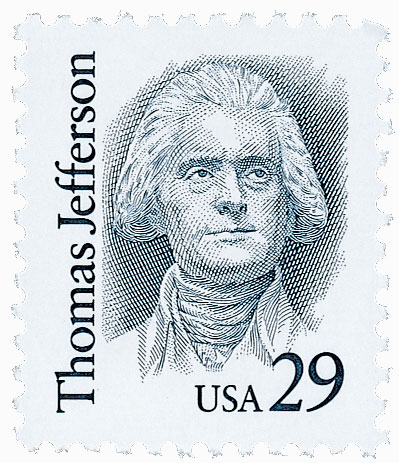
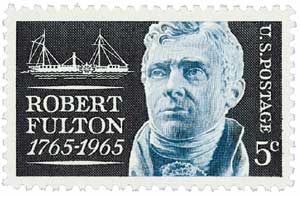
Read more about Houdon’s life and work and view photos of his sculptures.
Series of 1908-09 1¢ Franklin
Quantity issued: 5,300,000,000 (estimate)
Printed by: Bureau of Engraving and Printing
Method: Flat plate
Watermark: Double line
Perforation: 12
Color: Green
Birth of Jean-Antoine Houdon

Renowned sculptor Jean-Antoine Houdon was born on March 25, 1741, in Versailles, France. He sculpted a number of high-profile figures during his life, including George Washington, Benjamin Franklin, Voltaire, Thomas Jefferson, Robert Fulton, Napoleon Bonaparte, and more.
Houdon’s father was a servant who worked in the home of a high-ranking aristocrat. In 1749, that home began hosting the newly created Élèves Protégés, a special school for people who received the Prix de Rome. As a result, Houdon grew up surrounded by the day’s best crown-sponsored artists. He apprenticed with sculptor Michel Ange Slodtz and then won the Prix de Rome himself in 1761, enabling him to study at the Élèves Protégés.

Houdon enjoyed his time in Rome, studying classical sculptures. In fact, the students were tasked with copying famed marble sculptures that would be displayed in the royal gardens in France. Houdon returned to Paris in 1768 and was invited to show his work at the prestigious Salon. While his work was widely praised by many, he didn’t impress the director of major crown commissions. However, Houdon’s 1771 terracotta bust of French philosopher Denis Diderot earned him significant attention, particularly from foreign nobles and other high-society figures. Houdon created several busts of author Voltaire that inspired valuable commissions for seated Voltaire sculptures.

In the 1770s and 80s, Houdon befriended a number of American dignitaries living in Paris, including Benjamin Franklin, John Paul Jones, and Thomas Jefferson. He sculpted each of these men and Jefferson encouraged him to go to America to sculpt George Washington. Houdon spent weeks in 1785 at Washington’s Mount Vernon home and studied him carefully. On one occasion, Washington became angry about a horse trader’s prices and ordered the man off his property. At that moment, Houdon found the expression of pride and strength that inspired a nation. Houdon set off to capture the expression in his sculpture. The artist prepared a clay bust and a plaster life mask of Washington before returning to France to complete his work. Houdon’s bust of Washington is regarded as the most accurate representation of George Washington’s face in existence.

Houdon was commissioned to sculpt a wide variety of figures – magicians, magistrates, ministers, and the royal family. He also created plaster models of statues that he hoped would impress patrons to pay for them to be made in bronze or marble.

In 1786 he got married and had three daughters. His sculptures of them are considered some of his finest works picturing children. During the French Revolution he fell out of favor because of his connections to the royal court. But after the war, he again held a prominent position in the art community and worked on the Column of the Grand Armée. He was made a Chevalier of the Legion of Honor in 1804. He completed his final American commissions the year before, depicting inventor Robert Fulton and poet Joel Barlow. He also did his last commission for imperial Russia of Czar Alexander I. Houdon died on July 15, 1828.


Read more about Houdon’s life and work and view photos of his sculptures.




